2016's reading continues to be rewarding, and though perforce less swift now that I'm no longer on holiday, still moving along at a steady clip. This bunch of books includes several that I can already tell will be on my list of favorite reads at the end of the year. The Portable Veblen by Elizabeth McKenzie - This spring's it-litfic comes with blurbs by Ursula K. Le Guin and Karen Joy Fowler,
Add a CommentViewing: Blog Posts Tagged with: Frances Hardinge, Most Recent at Top [Help]
Results 1 - 16 of 16
Blog: Asking the Wrong Questions (Login to Add to MyJacketFlap)
JacketFlap tags: elizabeth knox, aliya whiteley, recent reading roundups, jane austen, frances hardinge, Add a tag
Blog: Asking the Wrong Questions (Login to Add to MyJacketFlap)
JacketFlap tags: books, essays, frances hardinge, Add a tag
The Lie Tree begins with a gloomy, wet boat journey to a gloomy, wet island in the English Channel. Fourteen-year-old Faith Sunderly, our protagonist, is moving with her family to the Isle of Vane, so that her father, the Reverend Erasmus Sunderly, can consult on an archaeological dig. It's the 1860s, and amateur natural scientists like Erasmus are grappling with the new, controversial theory
Add a CommentBlog: A Fuse #8 Production (Login to Add to MyJacketFlap)
JacketFlap tags: Fusenews, 2011 librarian previews, star wars, Rebecca Stead, Winnie-the-Pooh, The Poky Little Puppy, Where the Wild Things Are, Frances Hardinge, Me stuff, Phoenix Award, librarian attire, New Podcast Alert, Mathical Book Award, houses of a haunted nature, Add a tag
 Of all the most deserving, least lauded children’s book awards out there, my favorite might be The Phoenix Awards. “The award, given to a book originally published in the English language, is intended to recognize books of high literary merit. The Phoenix Award is named after the fabled bird who rose from its ashes with renewed life and beauty. Phoenix books also rise from the ashes of neglect and obscurity and once again touch the imaginations and enrich the lives of those who read them.” They’ve just announced the 2015 winner and I admit that I never read it (One Bird by Kyoko Mori). There was a time, when I was young, when I tried to read as many Phoenix books as possible. Someday, maybe, I’ll try again.
Of all the most deserving, least lauded children’s book awards out there, my favorite might be The Phoenix Awards. “The award, given to a book originally published in the English language, is intended to recognize books of high literary merit. The Phoenix Award is named after the fabled bird who rose from its ashes with renewed life and beauty. Phoenix books also rise from the ashes of neglect and obscurity and once again touch the imaginations and enrich the lives of those who read them.” They’ve just announced the 2015 winner and I admit that I never read it (One Bird by Kyoko Mori). There was a time, when I was young, when I tried to read as many Phoenix books as possible. Someday, maybe, I’ll try again.
- And speaking of obscure awards, did you see the Seven Impossible Things post on Kirkus recently called The Coolest Picture Book Award You’ve Never Heard Of … A lot of you folks should know about this. I suspect your books would be eligible (it’s for wildlife and nature).
- Heck, while we’re at it let’s also mention once more the Mathical Award which is given to books that “inspire young people to engage with mathematics in the world around them.” The submission info is here. Marc Aronson’s thoughts on the matter are here.
- For those of you in the market for ideas for your next middle grade novel, I suggest checking out this Dunmore, PA housing advertisement. Have at it. Thanks to Kate for the link.
- New Podcast Alert: You know I’m just goofy for new children’s literary podcasts. Heck, I once did an entire Literary Salon on the topic. Well, Ms. Julie Sternberg has just started Play, Memory. As she describes it: “I interview authors and others about the ways in which themes that recur in children’s literature–themes like the secrets we keep in childhood; the times we disappoint our parents; and the times our parents disappoint us–have played out in their lives.”
- And in other podcast news, there’s an interview with Fuse #8 favorite Frances Hardinge over at Tor.com. Because anything that has to do with Ms. Hardinge is awesome. I recently found myself having lunch at the same table as Patrick Ness and, at a loss of anything else to say to him, I realized we both belonged to the Mutual Admiration Society of Frances Hardinge. So to speak. Thanks to Sarah Hagge for the link.
- There’s a nice big post on endpapers up and running at Nancy Vo’s Illustration blog.
 This one’s rather interesting to me. Folks in my family often send me links that have to do with libraries or librarians in some way. I find some more useful than others. Still, I was very intrigued by the recent piece called The Archivist Files: Why the woman who started LA’s branch libraries was fired. Wowzah. Them’s good reading.
This one’s rather interesting to me. Folks in my family often send me links that have to do with libraries or librarians in some way. I find some more useful than others. Still, I was very intrigued by the recent piece called The Archivist Files: Why the woman who started LA’s branch libraries was fired. Wowzah. Them’s good reading.
Speaking of librarians, did you know there’s an entire site out there dedicated to them dressing up and posting pictures of themselves? Yup. Librarian Wardrobe. The more you know.
“But there’s a third set of children’s books: those that fall into an uncanny valley between enjoyable literature and ignorable junk. These are books that exert an irresistible pull on adult consciousness but don’t reward it. They are malign presences on the bookshelf. They hurt. One of them may be the best-selling children’s picture book of all time.” That’s a hard sentence to beat and, as it happens, I agree with author Gabriel Roth every which way from Sunday. He discusses what may be one of the worst “canonical” picture books of all time.
- A nice little write up of the panel I moderated at BEA called Telling the Truth at Every Age.
- This doesn’t actually have any connection to children’s literature really (though you might be able to make a case for it) but did you know that there’s a site created by NYPL where you can look at old photos of pretty much every single block in the city? It’s called OldNYC and I’ve just handed you a website that will eat away at your spare time for the rest of the day. You’re welcome.
- I was discussing this with buddy Gregory K the other day. Can you think of a single instance where a Newbery Award winner went out, after winning said award, and became an agent? Because that’s what Ms. Rebecca Stead has just done and I think it’s safe to say that it’s an unprecedented move.
- Daily Image:
So there’s this artist out there by the name of James Hance. And this, my friends, is just the tip of the iceberg in terms of the content he has available. Here’s a taste:
Thanks to Stephanie Whelan for the link.
Blog: A Fuse #8 Production (Login to Add to MyJacketFlap)
JacketFlap tags: Goodnight Moon, Dr. Seuss, obits, Shannon Hale, The Paper Bag Princess, summer slide, Nick Cave, Frances Hardinge, Alligator Pie, Chad Beckerman, Sebastian Meschenmoser, Fusenews, Marcia Brown, Jewell Parker Rhodes, Me and Earl and the Dying Girl, selfies, Funny Girl, children's literary history, Add a tag
 When two people sent me this link I assumed that everyone must have already seen it. But when it didn’t show up on PW Children’s Bookshelf I decided that perhaps I might have a scoop. At the very least, it appears that when people think Nick Cave meets Dr. Seuss, I’m the logical person to send that link to. And they’re right. I’ve been hoping for years that some karaoke bar I wander into might have “Red Right Hand” on the roster. So far it hasn’t worked out but I live in hope. Thanks to Stephanie Whelan and Marci for the link.
When two people sent me this link I assumed that everyone must have already seen it. But when it didn’t show up on PW Children’s Bookshelf I decided that perhaps I might have a scoop. At the very least, it appears that when people think Nick Cave meets Dr. Seuss, I’m the logical person to send that link to. And they’re right. I’ve been hoping for years that some karaoke bar I wander into might have “Red Right Hand” on the roster. So far it hasn’t worked out but I live in hope. Thanks to Stephanie Whelan and Marci for the link.
- Good old Kelly Gallucci at Bookish was kind enough to write a piece called 5 Reasons Why the Children’s Choice Book Awards Are Better Than the Oscars and All Other Awards Shows. She’s right about many things, particularly the food. It’s rather superb.
- There was a nice obituary in SLJ about Marcia Brown, the woman who currently holds the title of Most Caldecotts Ever Won By a Single Person (though David Wiesner looks to be catching up). She’s a former co-worker of mine, if by “co-worker” you give or take 50 years (we both worked in the Central Children’s Room, now called The Children’s Center at 42nd Street). Jeanne Lamb of NYPL gave some great background in this piece. I did speak to someone recently who was surprised that the Shadow controversy hasn’t come up in any obituaries discussing Ms. Brown’s life. I suspect that has more to do with our shortened memories than anything else, but it may be an indication of folks wishing to remember her in the best light.
- You know, just when you think Travis Jonker has come up with all the brilliant posts he’s going to, something like this comes along and blows it all out of the water. You, sir, are a certified genius. You, and your little Aaron Zenz too.
- Work on Funny Girl, my anthology, continues unabated. In that light, Shannon Hale’s magnificent post Stop Shushing the Funny Girls is particularly pertinent. Consider it your required reading of the day.
- “Social fluency will be the new currency of success.” The Shelftalker blog said that Jewell Parker Rhodes’s closing keynote, “Diversity and Character-Driven Stories,” at this year’s ABC Children’s Institute was worth reading and seems they’re absolutely right. Downright inspiring too. Maybe this should be your required reading.
- Nope. I was wrong. Those two posts are your required reading, on top of this one from Art Director Chad Beckerman. His Evolution of a Cover post on Me and Earl and the Dying Girl makes you wish he wrote such things daily. It also clarifies for many of us the sheer amount of work a single book jacket takes.
- This is coming to America next year. As such, I must respectfully ask the universe to please make next year come tomorrow. I am willing to wait 24 hours. See how patient I am? I think I deserve a treat.
- Let’s say you work in a library system where, for whatever reason, you need to justify a massive summer reading program. And let us say that what you need, what you really and truly want, are some cold, hard facts to back up the claim that there is such a thing as a “summer slide” (summer slide = the phenomenon of children sliding back a grade or two over the summer if they don’t read during that time) and that summer reading prevents it. Well, thanks to the efforts of RIF, we now have research to back us up. So for those of you fond of cold, hard facts, tip your hat to RIF.
- Celebrity selfies photoshopped to make them look like they’re reading? Oh. You know you want it. Minh Le, bravo.
 There’s just something about that Alligator Pie. When twenty-five graphic novelists were asked to name their favorite children’s books, not one but TWO of them mentioned Alligator Pie by Dennis Lee, illustrated by Frank Newfeld. Canadian to its core, it’s one of those classics that most Americans, heck most U.S. children’s librarians, just don’t know. Next time I’m in Stratford, Ontario I’m picking up a copy. After all, any book that influenced both Mariko Tamaki and John Martz has got to be doing something right.
There’s just something about that Alligator Pie. When twenty-five graphic novelists were asked to name their favorite children’s books, not one but TWO of them mentioned Alligator Pie by Dennis Lee, illustrated by Frank Newfeld. Canadian to its core, it’s one of those classics that most Americans, heck most U.S. children’s librarians, just don’t know. Next time I’m in Stratford, Ontario I’m picking up a copy. After all, any book that influenced both Mariko Tamaki and John Martz has got to be doing something right.
Did you hear about the diversity survey Lee & Low has spearheaded? Did you read the comments on the article? And do you know whether or not any of the big five have agreed to participate yet? Inquiring minds want to know.
- Sure, this news already ran in PW Children’s Bookshelf, but hearing it more than once never hurt anybody. We all have our pet favorites. Mine just happen to be German sometimes:
NorthSouth Books’ Associate Publisher, Andrew Rushton, has acquired a second book by German author/illustrator Sebastian Meschenmoser. Gordon & Tapir, which tells the comical story of odd-couple housemates (a particular penguin and an untidy tapir), received a Special Mention at the Bologna Ragazzi awards (category Fiction) and is short-listed for the German Children’s Book of the Year Award. The author will be on tour in the US this June ending at ALA in San Francisco.
- I miss Peter Sieruta. I miss him a lot. Nobody else had his wit and timing and sheer, crazy historical knowledge in strange obscure areas. So it was with great interest that I recently discovered Second Look Books. Librarian Carol Matic highlights older gems each week, giving a bit of context and history along the way. Good for those still going through Collecting Children’s Books withdrawal.
- Hooray! A new Children’s Books Made Horrific is always cause for celebration. Ever wanted Goodnight Moon to give you nightmares? Well consider your prayers answered . . .
- Daily Image:
Jules, I thought of you. Thanks to Stephanie Whelan for the image.
Blog: A Fuse #8 Production (Login to Add to MyJacketFlap)
JacketFlap tags: t-shirts, Dr. Seuss, NYPL, Pinocchio, Bambi, Frances Hardinge, Eloise, Dan Blank, Barry Goldblatt, poetry awards, Leo Lionni, Fusenews, Bank Street Bookstore, Tim Federle, The Cotsen Children's Library, We Need Diverse Books, Patience and Fortitude, Racebent, me stu, potential Christmas gifts, Roxanne Feldman, Spanish language children's books, Add a tag
- Top of the morning to you, froggies! I had one heckuva weekend, I tell you. Actually it was just one heckuva Saturday. First there was the opening of the new Bank Street Bookstore location here in NYC. I was one of the local authors in attendance and, as you can see from this photograph taken that morning, I was in good company.
At one point I found myself at a signing table between Deborah Heiligman and Rebecca Stead with Susan Kuklin, Chris Raschka, and Peter Lerangis on either side. I picked up the name tag that Jerry Pinkney had left behind so that I could at least claim a Caldecott by association. Of course that meant I left my own nametag behind and a certain someone did find it later in the day . . .
Then that afternoon, after wolfing down an Upper West Side avocado sandwich that had aspirations for greatness (aspirations that remained unfulfilled) I was at NYPL’s central library for the panel Blurred Lines?: Accuracy and Illustration in Nonfiction. This title of silliness I acknowledge mine. In any case, the line-up was Sophie Blackall, Brian Floca, Mara Rockliff, and her Candlewick editor Nicole Raymond. It was brilliant. There will perhaps be a write-up at some point that I’ll link to. I just wanted to tip my hat to the folks involved. We were slated to go from 2-3 and we pretty much went from 2-4. We could have gone longer.
- I’ve often said that small publishers fill the gaps left by their larger brethren. Folktales and fairy tales are often best served in this way. Graphic novels are beginning to go the same route. One type of book that the smaller publishers should really look into, though, is poetry. We really don’t see a lot of it published in a given year, and I’d love to see more. The new Lee Bennett Hopkins Poetry Award may help the cause. It was recently announced and the award is looking for folks who are SCBWI members and that published their books between 2013-2015. It makes us just one step closer to an ALA poetry award. One step.
- How did I miss this when it was published? It’s a New Yorker piece entitled Eloise: An Update. It had me at “The absolute first thing I do in the morning is make coffee in the bathroom and check to see what’s on pay-per-view / Then I have to go to the health club to see if they’ve gotten any new kettlebells and then stop at the business center to Google a few foreign swear words.” Thanks to Sharyn November for the link.
- Y’all know I worship at the alter of Frances Hardinge and believe her to be one of the greatest living British novelists working today, right? Well, this just in from the interwebs! Specifically, from agent Barry Goldblatt’s Facebook page:
BSFA and Carnegie Medal longlister Frances Hardinge’s debut adult novel THE KNOWLEDGE, about a London cab driver with a special license to travel between multiple alternative Londons, who, after rescuing a long-missing fellow driver, finds herself caught up in a widening conspiracy to control the pathways between worlds, to Navah Wolfe at Saga Press, in a two-book deal, for publication in Summer 2017, by Barry Goldblatt at Barry Goldblatt Literary on behalf of Nancy Miles at Miles Stott Literary Agency (NA).
Mind you, this means I’ll have to read an adult novel now. I’ll cross that bridge when I come to it.
- Speaking of England, I’m tired of them being cooler than us. For example, did you know that they have a Federation of Children’s Book Groups? A federation! Why don’t we have a federation? I’ll tell you why. Because we haven’t earned it yet. Grrr.
- Ooo! A new Spanish language children’s bookstore has just opened up in Los Angeles. And here we can’t get a single bookstore other than Barnes & Noble to open up in the Bronx in English, let alone another language. This is so cool. Methinks publishers looking to expand into the Latino market would do well to court the people working at this shop, if only to find new translatable material.
- Fancy fancy dancy dancy Leo Lionni shirts are now being sold by UNIQLO. Some samples:
Smarties.
- Roxanne Feldman is one of those women that has been in the business of getting books into the hands of young ‘uns for years and years and years. Online you may recognize her by her username “fairrosa”. Well, now she has a blog of her very own and it’s worth visiting. Called the Fairrosa Cyber Library, it’s the place to go. However – Be Warned. This is not a site to merely dabble in. If you go you must be prepared to sit down and read and read. Her recent posts about diversity make for exciting blogging.
- Phil Nel has compiled the greatest Dr. Seuss blog post of all time. I said it. I stand by it. Doubt me if you dare.
- Me Stuff: Because apparently the whole opening of this blog post didn’t count. Now Dan Blank is one of those guys you just hope and pray you’ll meet at some point in your life. He’s the kind of fellow who is infinitely intensely knowledgeable about how one’s career can progress over time and he’s followed my own practically since the birth of my blogging career. If I appeared in Forbes, it was because of Dan. Recently he interviewed me at length and the post is up. It’s called Betsy Bird: From “Invisible” Introvert to Author, Critic, Blogger and Librarian. I feel like that kid in Boyhood with Dan. Really I do.
- It was Adam Gidwitz who alerted me to a theatrical production going on in town right now that holds my interest in its hot little hand. He says the company is fantastic and that the show is entirely worth it. Though, with a name like BAMBIF*CKER/KAFFEHAUS: A caffeinated ride through sex, death, deer, and Zionism how could it not be?
- Fact: The Cotsen Children’s Library of Princeton has been interviewing great authors and illustrators since at least 2010.
- Fact: Access to these interviews has always been available, but not through iTunes.
- Fact: Now it is. And it’s amazing. Atinuke. Gary Schmidt. Rebecca Stead. Philip Pullman. It’s free, it’s out there, so fill up your iPod like I am right now and go crazy! Thanks to Dana Sheridan for the info!
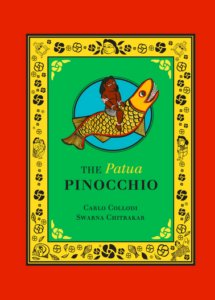 The other day I linked to a piece on the term “racebent” and how it applies to characters like Hermione in Harry Potter. It’s not really a new idea, though, is it? Folks have always reinterpreted fictional characters in light of their own cultures. This year the publisher Tara Books is releasing The Patua Pinocchio. Now I’ve been a bit Pinocchio obsessed ever since my 3-year-old daughter took Kate McMullen’s version to heart (it was the first chapter book she had the patience to sit through). With that in mind I am VERY interested in this version of the little wooden boy. Very.
The other day I linked to a piece on the term “racebent” and how it applies to characters like Hermione in Harry Potter. It’s not really a new idea, though, is it? Folks have always reinterpreted fictional characters in light of their own cultures. This year the publisher Tara Books is releasing The Patua Pinocchio. Now I’ve been a bit Pinocchio obsessed ever since my 3-year-old daughter took Kate McMullen’s version to heart (it was the first chapter book she had the patience to sit through). With that in mind I am VERY interested in this version of the little wooden boy. Very.
- Ever been a children’s nonfiction conference? Want to? The 21st Century Children’s Nonfiction Conference has moved to NYC this year and it’s going to be a lot of fun. I’ll be speaking alongside my colleague / partner-in-crime Amie Wright, but there are a host of other speakers and it’s a delightful roster. If ever this has ever been your passion, now’s thWe time to go.
- Diverse books for kids don’t sell? To this, Elizabeth Bluemle, a bookseller, points out something so glaringly obvious that I’m surprised nobody else has mentioned it before. I’m sure that someone has, but rarely so succinctly. Good title too: An Overlooked Fallacy About Sales of Diverse Books.
- And speaking of diverse books, here’s something that was published last year but that I, in the throes of the whole giving birth thing, missed. The We Need Diverse Books website regularly posted some of the loveliest book recommendations I’ve ever seen. We’ve all seen lists that say things like “Like This? Then Try This!” but rarely do they ever explain why the person would like that book (I’m guilty of this in my own reviews’ readalikes and shall endeavor to be better in the future). On their site, the WNDB folks not only offered diverse readalikes to popular titles, but gave excellent reasons as to why a fan of David Wiesner’s Tuesday might like Bill Thomson’s Chalk. The pairing of Lucy Christopher’s Stolen with Sharon Draper’s Panic is particularly inspired. The covers even match.
Daily Image:
I am ever alert to any appropriation of my workplace that might be taking place. Recently I learned that in the Rockettes’ upcoming holiday show there will be this set in one of the numbers. Apparently Patience and Fortitude (the library lions) will be voiced by (the recorded voices of) Tina Fey and Amy Poehler. I kid you not.
Years ago when I worked in the old Donnell Library I looked out the window of the Central Children’s Room to see three camels standing there chewing their cud or whatever it is that camels chew. They were with their trainer, taking a walk before their big number in the Rockettes’ show. The crazy thing was watching the people on the street. The New Yorkers were walking past like the it was the most natural thing in the world. This is because New Yorkers are crazy. When camels strike you as everyday, something has gone wrong with your life.
Blog: A Fuse #8 Production (Login to Add to MyJacketFlap)
JacketFlap tags: British imports, middle grade historical fantasy, middle school novels, Best Books of 2015, Reviews 2015, 2015 reviews, 2015 fantasy, 2015 middle school fiction, middle school fantasy, Reviews, horror, fantasy, middle grade fantasy, Best Books, Frances Hardinge, Add a tag
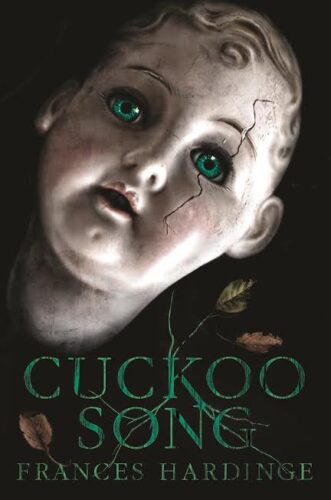 Cuckoo Song
Cuckoo Song
By Frances Hardinge
Amulet Books (an imprint of Abrams)
$17.95
ISBN: 978-1419714801
Ages 10 and up
On shelves May 12, 2015
I was watching the third Hobbit movie the other day (bear with me – I’m going somewhere with this) with no particular pleasure. There are few things in life more painful to a children’s librarian than watching an enjoyable adventure for kids lengthened and turned into adult-centric fare, then sliced up into three sections. Still, it’s always interesting to see how filmmakers wish to adapt material and as I sat there, only moderately stultified, the so-called “Battle of the Five Armies” (which, in this film, could be renamed “The Battle of the Thirteen Odd Armies, Give Or Take a Few) comes to a head as the glorious eagles swoop in. “They’re the Americans”, my husband noted. It took a minute for this to register. “What?” “They’re the Americans. Tolkien wrote this book after WWI and the eagles are the Yanks that swoop in to save the day at the very last minute.” I sat there thinking about it. England has always had far closer ties to The Great War than America, it’s true. I remember sitting in school, baffled by the vague version I was fed. American children are taught primarily Revolutionary War, Civil War, and WWII fare. All other conflicts are of seemingly equal non-importance after those big three. Yet with the 100 year anniversary of the war to end all wars, the English, who had a much larger role to play, are, like Tolkien, still producing innovative, evocative, unbelievable takes that utilize fantasy to help us understand it. And few books do a better job of pinpointing the post traumatic stress syndrome of a post-WWI nation than Frances Hardinge’s Cuckoo Song. They will tell you that it’s a creepy doll book with changelings and fairies and things that go bump in the night. It is all of that. It is also one of the smartest dissections of what happens when a war is done and the survivors are left to put their lives back together. Some do a good job. Some do not.
Eleven-year-old Triss is not well. She knows this, but as with many illnesses she’s having a hard time pinpointing what exactly is wrong. It probably had to do with the fact that she was fished out of the Grimmer, a body of water near the old stone house where her family likes to vacation. Still, that doesn’t explain why her sister is suddenly acting angry and afraid of her. It doesn’t explain why she’s suddenly voracious, devouring plate after plate of food in a kind of half mad frenzy. And it doesn’t explain some of the odder things that have been happening lately either. The dolls that don’t just talk but scream too. The fact that she’s waking up with dead leaves in her hair and bed. And that’s all before her sister is nearly kidnapped by a movie screen, a tailor tries to burn her alive, and she discovers a world within her world where things are topsy turvy and she doesn’t even know who she is anymore. Triss isn’t the girl she once was. And time is running out.
From that description you’d be justified in wondering why I spent the better half of the opening paragraph of this review discussing WWI. After all, there is nothing particularly war-like in that summary. It would behoove me to me mention then that all this takes place a year or two after the war. Triss’s older brother died in the conflict, leaving his family to pick up the pieces. Like all parents, his are devastated by their loss. Unlike all parents, they make a terrible choice to keep him from leaving them entirely. It’s the parents’ grief and choices that then become the focal point of the book. The nation is experiencing a period of vast change. New buildings, new music, and new ideas are proliferating. Yet for Triss’s parents, it is vastly important that nothing change. They’re the people that would prefer to live in an intolerable but familiar situation rather than a tolerable unknown. Their love is a toxic thing, harming their children in the most insidious of ways. It takes an outsider to see this and to tell them what they are doing. By the end, it’s entirely possible that they’ll stay stuck until events force them otherwise. Then again, Hardinge leaves you with a glimmer of hope. The nation did heal. People did learn. And while there was another tragic war on the horizon, that was a problem for another day.
So what’s all that have to do with fairies? In a smart twist Hardinge makes a nation bereaved become the perfect breeding ground for fairy (though she never calls them that) immigration. It’s interesting to think long and hard about what it is that Hardinge is saying, precisely, about immigrants in England. Indeed, the book wrestles with the metaphor. These are creatures that have lost their homes thanks to the encroachment of humanity. Are they not entitled to lives of their own? Yet some of them do harm to the residents of the towns. But do all of them? Should we paint them all with the same brush if some of them are harmful? These are serious questions worth asking. Xenophobia comes in the form of the tailor Mr. Grace. His smooth sharp scissors cause Triss to equate him with the Scissor Man from the Struwwelpeter tales of old. Having suffered a personal loss at the hands of the otherworldly immigrants he dedicates himself to a kind of blind intolerance. He’s sympathetic, but only up to a point.
Terms I Dislike: Urban Fairies. I don’t particularly dislike the fairies themselves. Not if they’re done well. I should clarify that the term “urban fairies” is used when discussing books in which fairies reside in urban environments. Gargoyles in the gutters. That sort of thing. And if we’re going to get technical about it then yes, Cuckoo Song is an urban fairy book. The ultimate urban fairy book, really. Called “Besiders” their presence in cities is attributed to the fact that they are creatures that exist only where there is no certainty. In the past the sound of church bells proved painful, maybe fatal. However, in the years following The Great War the certainty of religion began to ebb from the English people. Religion didn’t have the standing it once held in their lives/hearts/minds, and so thanks to this uncertainty the Besiders were able to move into places in the city made just for them. You could have long, interesting book group conversations about the true implications of this vision.
There are two kinds of Frances Hardinge novels in this world. There are the ones that deal in familiar mythologies but give them a distinctive spin. That’s this book. Then there are the books that make up their own mythologies and go into such vastly strange areas that it takes a leap of faith to follow, though it’s worth it every time. That’s books like The Lost Conspiracy or Fly By Night and its sequel. Previously Ms. Hardinge wrote Well Witched which was a lovely fantasy but felt tamed in some strange way. As if she was asked to reign in her love of the fabulous so as to create a more standard work of fantasy. I was worried that Cuckoo Song might fall into this same trap but happily this is not the case. What we see on the page here is marvelously odd while still working within an understood framework. I wouldn’t change a dot on an i or a cross on a t.
Story aside, it is Hardinge’s writing that inevitably hooks the reader. She has a way with language that sounds like no one else. Here’s a sentence from the first paragraph of the book: “Somebody had taken a laugh, crumpled it into a great, crackly ball, and stuffed her skull with it.” Beautiful. Line after line after line jumps out at the reader this way. One of my favorites is when a fellow called The Shrike explains why scissors are the true enemy of the Besiders. “A knife is made with a hundred tasks in mind . . . But scissors are really intended for one job alone – snipping things in two. Dividing by force. Everything on one side or the other, and nothing in between. Certainty. We’re in-between folk, so scissors hate us.” If I had half a mind to I’d just spend the rest of this review quoting line after line of this book. For your sake, I’ll restrain myself. Just this once.
When this book was released in England it was published as older children’s fare, albeit with a rather YA cover. Here in the States it is being published as YA fare with a rather creepy cover. Having read it, there really isn’t anything about the book I wouldn’t readily hand to a 10-year-old. Is there blood? Nope. Violence? Not unless you count eating dollies. Anything remarkably creepy? Well, there is a memory of a baby changeling that’s kind of gross, but I don’t think you’re going to see too many people freaking out over it. Sadly I think the decision was made, in spite of its 11-year-old protagonist, because Hardinge is such a mellifluous writer. Perhaps there was a thought to appeal to the Laini Taylor fans out there. Like Taylor she delves in strange otherworlds and writes with a distinctive purr. Unlike Taylor, Hardinge is British to her core. There are things here that you cannot find anywhere else. Her brain is a country of fabulous mini-states and we’ll be lucky if we get to see even half of them in our lifetimes.
There was a time when Frances Hardinge books were imported to America on a regular basis. For whatever reason, that stopped. Now a great wrong has been righted and if there were any justice in this world her Yankee fans would line the ports waiting for her books to arrive, much as they did in the time of Charles Dickens. That she can take an event like WWI and the sheer weight of the grief that followed, then transform it into dark, creepy, delicious, satisfying children’s fare is awe-inspiring. You will find no other author who dares to go so deep. Those of you who have never read a Hardinge book, I envy you. You’re going to be discovering her for the very first time, so I hope you savor every bloody, bleeding word. Taste the sentences on your tongue. Let them melt there. Then pick up your forks and demand more more more. There are other Hardinge books in England we have yet to see stateside. Let our publishers fill our plates. It’s what our children deserve.
On shelves May 15th.
Source: Reviewed from British edition, purchased by self.
Like This? Then Try:
- Daugher of Smoke and Bone by Laini Taylor
- Doll Bones by Holly Black
- Splendors and Glooms by Laura Amy Schlitz
Other Blog Reviews:
- Here’s the review from The Book Smugglers that inspired me to read this in the first place.
- And here’s pretty much a link to every other review of this book . . . um . . . ever.
Spoiler-ific Interviews: The Book Smugglers have Ms. Hardinge talk about her influences. Remember those goofy television episodes from the 70s and 80s where dopplegangers would cause mischief. Seems they gave at least one girl viewer nightmares.
Blog: A Fuse #8 Production (Login to Add to MyJacketFlap)
JacketFlap tags: Children's Literary Salon, All-of-a-Kind Family, Muslim Americans, podcasts, Native Americans, Richard Scarry, Barbie, Jacqueline Woodson, NBC, Politics and Prose, Frances Hardinge, Latino children's books, Fusenews, celebrity children's authors (may they rot), Add a tag
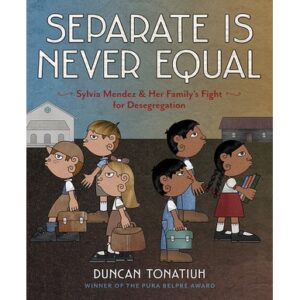 There was a time, oh children of mine, when the ALA Media Awards would be announced and the morning after the announcement the winners of the Caldecott and Newbery Awards would be whisked away to New York City to speak on NBC. Then Snooki came and ruined everything (this is the abbreviated version, but it’s not too far off). So we’re none too pleased with NBC these days. Al Roker’s Book Club aside (and it looks like it hasn’t updated since Halloween) there’s not a lot going on at that channel. But then they go and post the Latinas for Latino Lit: “Remarkable” Children’s Books of 2014 piece (selected by Viviana Hurtado and Monica Olivera) and much is forgiven. Just one question about the list, though . . . no Viva Frida?
There was a time, oh children of mine, when the ALA Media Awards would be announced and the morning after the announcement the winners of the Caldecott and Newbery Awards would be whisked away to New York City to speak on NBC. Then Snooki came and ruined everything (this is the abbreviated version, but it’s not too far off). So we’re none too pleased with NBC these days. Al Roker’s Book Club aside (and it looks like it hasn’t updated since Halloween) there’s not a lot going on at that channel. But then they go and post the Latinas for Latino Lit: “Remarkable” Children’s Books of 2014 piece (selected by Viviana Hurtado and Monica Olivera) and much is forgiven. Just one question about the list, though . . . no Viva Frida?
- What is the state of children’s nonfiction in the UK today? For our answer we turn to my favorite British blog Playing By the Book which reveals revelation after revelation in the piece Do We Care About Children’s Non-Fiction? Apparently informational books don’t get reviewed all that often in the U.K. Do the British value nonfiction then? Definitely fascinating reading.
- “I mean, seriously, can you think of one popular show/movie that actually tries to portray Muslims accurately instead of as a confining stereotype?” The excellent Summer writes on her blog Miss Fictional’s World of YA the piece I Am Not Oppressed. In particular she’s not particularly pleased with how Muslim women are depicted on the bulk of our book jackets (to say nothing of the content inside).
- Hm. So Entertainment Weekly just released a list of 50 Books Every Kid Should Read. Interesting, yes? And the choices are fascinating. They made an effort to do the classics and then work in some contemporary titles. What they chose is telling. Little Willow presents the list and leads the discussion as well.
- Um . . .
Okaaaaay. So that’s what Evangeline Lilly wore to her children’s book signing at Barnes & Noble. Clearly this is the outfit children’s authors should all be wearing now. Those of you hankering to wear your picnic blanket as a skirt now finally have an excuse to do so. Thanks to Jules for the link.
- I think roughly 500 people sent me the Richard Scarry’s Busy Town in the 21st Century link, to which I say to each and every last one of you – THANK YOU!! Good old Tom the Dancing Bug.
- Oh! How useful! PW recently published a rather lovely assessment of Children’s and YA Writing M.F.A. Programs around the country. Apparently they already covered Simmons in a previous post.
- And now, the best news of the week. My love for the author Frances Hardinge knows no bounds. Honestly, I do believe that The Lost Conspiracy may be my favorite children’s book published in the last 10 years. It’s a serious contender in any case. So you can imagine how distraught I was when it became clear that Harper Collins would no longer be publishing her books in the U.S. I watched miserably as the U.K. published A Face Like Glass and Cuckoo Song (read the Book Smugglers review of the latter) overseas. Heck, I actually shelled out money and bought the darn books myself (and you know how I feel about spending money). Then, yesterday, a miracle. I was paging through the Spring 2015 Abrams catalog and there she was. Frances. And Cuckoo Song, it said, would be published in May with what may well be the creepiest cover . . . um, ever? Yeah. Ever. It’s not even online yet, so just stay tuned because when it is you know I’ll be blogging it. So excited. (pssst! Abrams! Let me do the cover reveal!)
- If you missed the whole Barbie, Computer Programmer children’s book debacle, now’s your time to catch up. This was the inciting incident. This was the follow-up.
- The nice thing about working for NYPL is that they give me an awful lot of leeway when it comes to programming. I want to do a monthly series of Children’s Literary Salons on a host of different topics? Go to it! Any topic I like. The best ones, however, are often suggested by other people. For example, when editors Cheryl Klein and Stacy Whitman suggested we have a panel on Native American YA literature where authors Eric Gansworth and Joseph Bruchac could talk about the cross-cultural pleasures and challenges of working with their editors, I was all for it. Sadly, most of my Lit Salons are not recorded . . . but this one was! Cheryl, you see, is married to James Monohan and together they run the blog The Narrative Breakdown. My Salon? It became one of the episodes and you can listen to it here. As for those of you interested in attending a Salon (they’re free after all) there’s one this coming Saturday and you can see the full roster of them here.
- This thing. More libraries should do this thing. Yes.
- A few things. Jacqueline Woodson wrote a New York Times piece about the incident at the National Book Awards. There is that. Now I would also recommend that you read two additional pieces as well. I Am Racist and I Am Sexist and Probably Some Other -Ists, Too. The other is just called Racist.
- Speaking of Ms. Woodson, did you see the list of books President Obama purchased at Politics and Prose last Saturday? If we just pull out the children’s book fare it included:
- “Junie B. Jones and a Little Monkey Business” by Barbara Park
- “A Barnyard Collection: Click, Clack, Moo and More” by Doreen Cronin
- “I Spy Sticker Book and Picture Riddles” by Jean Marzollo
- “Nuts to You” by Lynn Rae Perkins
- “Junie B. Jones and the Stupid Smelly Bus” by Barbara Park
- “Brown Girl Dreaming” by Jacqueline Woodson
- “Redwall” by Brian Jacques
- “Mossflower” by Brian Jacques
- “Mattimeo” by Brian Jacques
- “Cartwheeling in Thunderstorms” by Katherine Rundell
- Daily Image:
I consider this my early Christmas present. Years ago when I did the Top 100 Children’s Novels poll, I did a post on All-of-a-Kind Family by Sydney Taylor that included every book cover I could find of the title. All but one. The book jacket I grew up with appeared to be lost to the sands of time. And now, all thanks to Sadie Salome, it’s been returned to me. Behold the only work of historical fiction I read independently and for fun as a kid from cover to cover:
Still the best, so far as I’m concerned. Thanks, Sadie.
Blog: An Awfully Big Blog Adventure (Login to Add to MyJacketFlap)
JacketFlap tags: interview, fairy tales, historical fiction, fantasy, Frances Hardinge, C.J. Busby, C.J.Busby, Cuckoo Song, Add a tag
I first met Frances Hardinge as part of an intrepid SAS contingent that stormed the World Fantasy Convention in Brighton in October 2013. We had a great time, although there were fewer costumes than I'd hoped, and no centaurs galloping through the plenary session...
 |
| Myself, Teresa Flavin and Katherine Roberts do the costume thing... |
 |
| Waiting for fish and chips |
It's been a pleasure. Pass the ketchup!
 Website: www.cjbusby.co.uk
Website: www.cjbusby.co.ukBlog: A Fuse #8 Production (Login to Add to MyJacketFlap)
JacketFlap tags: superheroes, William Joyce, Frances Hardinge, 826NYC, Fusenews, New Blog Alerts, Little Town on the Prairie, Else Holmelund Minarik, literary retreats, Uncategorized, Add a tag
 Well, now we’ve gone and done it. Greedy gus that I am, I’ve always found it hugely inconvenient when my favorite authors and illustrators live in other countries. Shaun Tan in Australia. Kate Beaton in Canada (we had her briefly, then lost her again, consarn it). And then there’s that charming Frances Hardinge. When are we going to convince her to move Stateside? Never if the publication of her latest book is any indication. Or, shall I say, the LACK of publication since if you are looking for her latest novel A Face Like Glass here in America you are seriously out of luck. Not entirely without options, mind you, since you can buy a Kindle edition (the hardcover claims to come out May 1st yet has “not yet been released” and has no American publisher) which is pretty much your only option if you’re a Yank. Harper Collins has traditionally been the publisher of all the Hardinge books in the States but is eschewing her latest novel. Unless, of course, they’re just biding their time until the spring. However, if they do not opt for her latest I’d be more than happy to see some other publisher pick up the slack. Recall, if you will, the fact that the last Hardinge won the 2010 Battle of the (Kids’) Books. Just sayin’. Thanks to Dan Levy for the info.
Well, now we’ve gone and done it. Greedy gus that I am, I’ve always found it hugely inconvenient when my favorite authors and illustrators live in other countries. Shaun Tan in Australia. Kate Beaton in Canada (we had her briefly, then lost her again, consarn it). And then there’s that charming Frances Hardinge. When are we going to convince her to move Stateside? Never if the publication of her latest book is any indication. Or, shall I say, the LACK of publication since if you are looking for her latest novel A Face Like Glass here in America you are seriously out of luck. Not entirely without options, mind you, since you can buy a Kindle edition (the hardcover claims to come out May 1st yet has “not yet been released” and has no American publisher) which is pretty much your only option if you’re a Yank. Harper Collins has traditionally been the publisher of all the Hardinge books in the States but is eschewing her latest novel. Unless, of course, they’re just biding their time until the spring. However, if they do not opt for her latest I’d be more than happy to see some other publisher pick up the slack. Recall, if you will, the fact that the last Hardinge won the 2010 Battle of the (Kids’) Books. Just sayin’. Thanks to Dan Levy for the info.
- Speaking of Brits, a fascinating article came out in The Guardian recently posing the question: “Which books offer the best introduction to New York?“ The answer was a fascinating mix of the usual suspects (Mixed-Up Files, Eloise, Little Red Lighthouse, etc.) and stuff that would never occur to me, the New York Public Library Youth Materials Specialist. Grk and the Hot Dog Trail? In the Night Kitchen? The Arrival?!? I pity the poor child that walks into Manhattan with The Arrival as their guide. Think of their disappointment (particularly when you consider that Tan took as much inspiration from classic Australian photographs as American ones). Almost more interesting than all of these is the recommendation to read Rosa Guy’s books. When we think of New York we almost never take her into consideration. As I say, fascinating. Thanks to Playing By the Book for the link.
- Speaking of New York City, heads up, hipsters. Actually, a better way of putting this would be to say heads up those of you who want to hang out with famous people for a reasonable price and an even better cause. 826NYC is having its Dueling Bingos competition, and this season you’re going to have a chance to match your Bingo chops against folks like Sarah Vowell, the guy who plays “Pete” on 30 Rock, Catherine Keener, and maybe even Jon Scieszka if you’re lucky. Are you in town August 1st? Then you have no excuse. Come by, come by . . .
 Is it just me or are more people dying this
7 Comments on Fusenews: Rectify this sin, last added: 7/19/2012Display Comments Add a Comment
Is it just me or are more people dying this
7 Comments on Fusenews: Rectify this sin, last added: 7/19/2012Display Comments Add a Comment
Blog: A Fuse #8 Production (Login to Add to MyJacketFlap)
JacketFlap tags: banned books, Uncategorized, fairy tales, Reading is Fundamental, Sherlock Holmes, cheese, Lois Ehlert, Eric Carle Museum, Kidlitosphere Conference, Jack Zipes, Frances Hardinge, Fusenews, Philip Nel, children's literary scholarship, Faith Erin Hicks, Michael di Capua, Would you like to come up and see my etchings?, Add a tag
 The fabulous Colleen Mondor and Jackie Parker-Robinson have come up with a clever notion. Kidlitcon, the yearly conference for bloggers of child and teen literature, fast approacheth and this year, things are getting a bit switched. As Colleen says on her blog, “What we decided was to shift things just a bit, both by moving away from publisher donated ARCs as raffle prizes and also toward a long term partnership with one organization. Ultimately what we came up with made sense in so many ways that in retrospect it was one of the easiest things we decided. I am delighted to announce that KidLit Con is now entering into a partnership with Reading Is Fundamental which we hope will extend for many years into the future and make a powerful difference in the lives of many.” There’s more information to be found here, including info on how to donate to RIF yourself. So far the fund has reached $1,056, which is fantastic though more is needed. And a cheer is going out to Carol Rasco for her mention of me in a recent thank you.
The fabulous Colleen Mondor and Jackie Parker-Robinson have come up with a clever notion. Kidlitcon, the yearly conference for bloggers of child and teen literature, fast approacheth and this year, things are getting a bit switched. As Colleen says on her blog, “What we decided was to shift things just a bit, both by moving away from publisher donated ARCs as raffle prizes and also toward a long term partnership with one organization. Ultimately what we came up with made sense in so many ways that in retrospect it was one of the easiest things we decided. I am delighted to announce that KidLit Con is now entering into a partnership with Reading Is Fundamental which we hope will extend for many years into the future and make a powerful difference in the lives of many.” There’s more information to be found here, including info on how to donate to RIF yourself. So far the fund has reached $1,056, which is fantastic though more is needed. And a cheer is going out to Carol Rasco for her mention of me in a recent thank you.
- And now let’s raise a glass and toast my profession. Isn’t it nice to have a profession that can, without so much as a stray drop of guilt, be toasted? Lucky that. In any case, the I Love My Librarian awards are starting up again and that means you need to get out there and vote for your beloved holders of MLIS degrees. You may nominate a school, public, and academic librarian if you like. Doesn’t cost you a thing and maybe your one true library love will get the credit they so richly deserve. Stranger things have happened, no?
- Speaking of honoring folks, the Eric Carle Museum Honors have been announced. Each year four categories are filled with folks who have done some good in the name of children’s literature. This year the recipients include:
Lois Ehlert ▪ Artist
Jeanne Steig ▪ Angel
Michael di Capua ▪ Mentor
Karen Nelson Hoyle ▪ Bridge
On Thursday, September 22nd the Honors will be at Guastavino’s here in town. The usual auction that takes place at that time is seeing a bit of a shake-up as well. According to the website, “Our fourth annual art auction will feature original works of art donated by some of the industry’s most celebrated artists. This year also offers the opportunity to bid on ‘experiences’ with authors and artists.” If one of those “experiences” can include a chance to go pubbing with Tomi Ungerer I am in! At last year’s event I discovered that I was pregnant mere hours before attending. This year will have to top that, right?
- Back in the day when I was young and foolish I had a chance to interview Frances Hardinge on my blog. Years have passed and Ms. Hardinge has yet to become the household name here in the States that I know she is capable of being. While I wait then I’ll continue to read other interviews of her, like 0 Comments on Fusenews: Now with more earthquaky goodness as of 1/1/1900
Blog: Playing by the book (Login to Add to MyJacketFlap)
JacketFlap tags: Frances Hardinge, Author / Illustrator Interviews, Just So Festival, Add a tag
Yesterday Ali of Fantastic Reads very kindly and engagingly interviewed Frances Hardinge, 2006 winner of the Branford Boase award and finalist in the 2010 School Library Journal Battle of the Kids’ Books.
Although I didn’t manage to meet with Ali and Frances for their interview, I did ask Frances by email if she would share with us 8 books which reflect pivotal moments in her life so far, with particular reference to her journey towards becoming a published author. Here’s what she had to say…
“These are all books which I read for the first time during my childhood or teens, and which had a big effect upon me, and ultimately upon my writing.”
 Book no. 1
Book no. 1
James and the Giant Peach by Roald Dahl
“I was very young when I first read this book, and I still remember my disbelief when, on the first page, the hero’s idyllic home life was interrupted by his parents being killed by a runaway rhinoceros. The overturn of expectations was shocking and liberating, as if a window had been thrown open in my head. It was wonderful.”
 Book no. 2
Book no. 2
Alice’s Adventures in Wonderland by Lewis Carroll
“I loved this book long before I knew what the world ‘surrealism’ meant. It gave me my first hints that something could be powerful and recognisable without making sense in an ordinary way.”
 Book no. 3
Book no. 3
Smith by Leon Garfield
“I think this book more than any other sparked off my love affair with fiction in a historical setting, and later my enthusiasm for eighteenth and nineteenth century fiction.”
 Book no. 4
Book no. 4
Watership Down by Richard Adams
“This was the first epic I ever read, and was a lesson in the art of myth-making.”
0 Comments on 8 books which influenced Frances Hardinge as of 1/1/1900
Blog: A Fuse #8 Production (Login to Add to MyJacketFlap)
JacketFlap tags: Uncategorized, book trailers, Peter H. Reynolds, puppets, Laini Taylor, N.D. Wilson, Sesame Street, Frances Hardinge, Rosalyn Schanzer, Cressida Cowell, How to Train Your Dragon, Video Sunday, stage adaptations, Add a tag
We begin this week with something extraordinary. A book trailer that looks like a movie trailer (no real surprises there) but that includes so many specific details to its book that you’re half inclined to think that the movie version already exists. Super 8’s actor Joel Courtney stars in trailer for The Dragon’s Tooth by ND Wilson. What’s funny about it is that its locations are eerily perfect, the scenes amazing, and yet it has one aspect that makes me sad. You see, the hero of this book and his sister are dark skinned. Yet here you can see that they’re pretty darn white. To be fair this is entirely due to the fact that Mr. Courtney is friends with Mr. Wilson’s kids and that’s how he got the part. Still . . . sigh. Ditto the fact that an elderly woman from the book now appears to be 45. Perhaps elderly actresses are difficult to find sometimes? But aside from all that this is a remarkable piece of work. Maybe the best movie-like book trailer I’ve ever seen. Little wonder since it was directed by the author himself! If that whole writing books thing doesn’t work out, I can see a second career ready and waiting. Thanks to Heather Wilson for the link.
Along similar lines is this trailer for Laini Taylor’s Daughter of Smoke and Bone. When you’ve been following an author since day one, there’s an instinct to claim them. I loved Ms. Taylor when she wrote her Faeries of Dreamdark books back in the day. Now she’s hugely popular and I feel very possessive of her. With a whopping 50,000+ views (holy moses!) this next video is not as sophisticated as Wilson’s, but it has its own ineffable charm, no?
A very different kind of book trailer involves the recent winner of The Society of Illustrator’s Original Art gold medal. I daresay that this is the first time in my own recollection that a nonfiction title has won the award (and from National Geographic at that!). And I can think of no better way to see the art than this little video right here:
Gorgeous. Thanks to Jules Danielson for the link!
If I hadn’t begun with all those book trailers I probably would have begun with this glimpse of the staged production of How to Train Your Dragon in Australia. Because when it comes to stage puppetry, you ain’t never NEVER seen nuthin’ like this:
Blog: A Fuse #8 Production (Login to Add to MyJacketFlap)
JacketFlap tags: Uncategorized, puppets, geese, Frances Hardinge, Tales from NYPL, The Crazed Poultry Theory, Add a tag
 Come gather round me children and hear the tale I tell.
Come gather round me children and hear the tale I tell.
Cute goose, right? Well I don’t usually recount stories from my workplace, it being all marbley and imposing and such, but this is a good story. It involves a goose rescue mission, Long Island City, and Brian Selznick, not necessarily in that order. I explain.
In 2006 I was a new blogger, a relatively new children’s librarian, and I became acquainted with a new (at that point) British author. Her name was Frances Hardinge and she had recently published her first novel Fly By Night on either side of the Atlantic. I instantly fell in love with the book, not least because it featured a homicidal goose. All books, I have come to expect, would benefit from the simple addition of a homicidal goose. In any case, back then NYPL had big meetings of children’s librarians where we’d swap ideas for readalouds and booktalks. And I got it into my head that the best possible way to do a Fly By Night booktalk would be with a goose puppet.*
One problem: They don’t exist. Or rather, nice ones don’t. At the time of my brilliant notion the goose pickings were slim. I managed to find images of a really lovely gander from Folkmanis, but sadly it was out of stock (never, I now see, to return). So in a fit of pique I wrote in December of 2006:
“By the way, anyone that procures for me an Out of Stock Folkmanis goose puppet wins my heart, my mind, and any other intangible parts of my self they wish to lay claim to. I’d love to do some booktalking with my very own Saracen on my arm. Can’t you imagine me talking to kids as the goose hisses like a veritable fiend at them?”
So Brian Selznick sent me a goose puppet.
This is actually true. Some of you may be aware of Mr. Selznick’s puppet connections. He’s been active in the puppet scene for years, and has accumulated a couple here and there. The goose, however, had been a kind of gift. As he wrote me:
“When I was working on The Dinosaurs of Waterhouse Hawkins I was bitten by a goose in the park where the dinosaurs still stand in London. A bookseller gave me this goose puppet in honor of that somewhat painful incident.”
Brian didn’t need the goose, and when he read my plea on my blog (I had made him a Hot Man of Children’s Literature the previous March) he was inspired to lend me a hand. This is because he is a stand up fella.
So I had me a Selznick goose on my hands! And it really is a lovely thing. So downy and white. My regular storytime puppet is a Folkmanis white mouse named Basil that cannot be beat for sheer expressiveness (proof here) but Saracen the goose turned out to have his own charms. And so we were happy for a time. Until 2008 rolled around, that is.
In 2008 the Donnell branch of New York Public Library was sold. Every part of the enormous library had to vacate, including the Central Children’s Room. We’d had five children’s librarians working in a large children’s room doing all kinds of programs for fun. Now we had three and we needed to go live elsewhere. Fortunately, we landed at the main branch of NYPL where, from 1911 to 1970, the room had existed in the first place! Score!
In the course of packing up we hired a set of movers who, I must say, did a splendid job. And here is where the story takes a b
Blog: A Fuse #8 Production (Login to Add to MyJacketFlap)
JacketFlap tags: 2011 reviews, Best Books of 2011, 2011 middle grade fiction, Uncategorized, Frances Hardinge, Add a tag
 Fly Trap
Fly Trap
By Frances Hardinge
Harper Collins
$16.99
ISBN: 978-0-06-088044-6
Ages 9-12
On shelves May 31, 2011
As I see it, reviewing a sequel is a peculiar enterprise. One can hardly review a book without suggesting to the reader that they read the previous novel as well. And in the rare case where the sequel is better than its predecessor, one’s positive review is sort of moot if it seems as though it’s recommending the first book in any way. This is my convoluted way of saying that I don’t like reviewing them. Heck, I don’t even like to even read sequels half the time. Usually when I do I simply get more of the same old, same old. There are some authors, however, that write such magnificent books that when their sequels do appear you are helpless to resist. Such is the case of Frances Hardinge. There are only a few children’s writers in this world that I will drop everything to read. Hardinge is one of the few. Years and years ago she gave the world Fly By Night, a marvelous girl/goose/con man tale of misfits who unwittingly influence huge events. The follow-up Fly Trap (called Twilight Robbery in the UK) reunites readers with familiar characters, but does not actually require the reader to have read (or even reread) the first. The result is a rollicking adventure start to finish that does not slot neatly into any contemporary category, but still winds up charming its readers.
When we last saw our heroes, the orphaned Mosca Mye with her homicidal good Saracen, her penchant for language, and her smart mouth was still in the company of the silver-tongued con man Eponymous Clent. Having helped spark a revolution in the city of Mandelion, the three have taken off for other towns and now need to escape further. In their travels they end up in the city of Toll. Here you have a residence where the moment of your birth shapes where you may exist. Some citizens live during the daylight hours and have all the perks society can offer. Others live during the night and must do whatever they can to survive. Mosca, for her part, has a “dark” name and it soon becomes clear that if she and Eponymous can’t raise the necessary funds to leave the town, she’ll be banished to the night and have to deal with the villains there. The two cook up a plan but soon find that there is more at work in Toll (and more wrong with it) than anyone could have initially suspected.
They’ll call this book “fantasy” because they will have nowhere else to put it. This, in spite of the fact that magic plays no part in Mosca Mye’s world. However, since the book takes place in an alternate world, the only category that comes close to defining it is, indeed, fantasy. For that reason, I’ll call it a fantasy here. Now someday I will get off my lazy heinie and write an article about the use of religion in fantastical children’s novels. Generally speaking, fantasies do one of three things with religion. (A) They ignore it (Harry Potter’s a good example of this). (B) They embrace it wholeheartedly ( 9 Comments on Review of the Day: Fly Trap by Frances Hardinge, last added: 4/7/2011



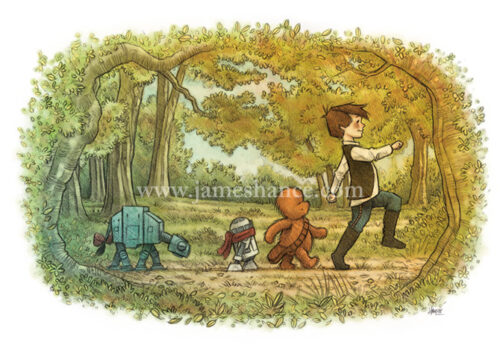


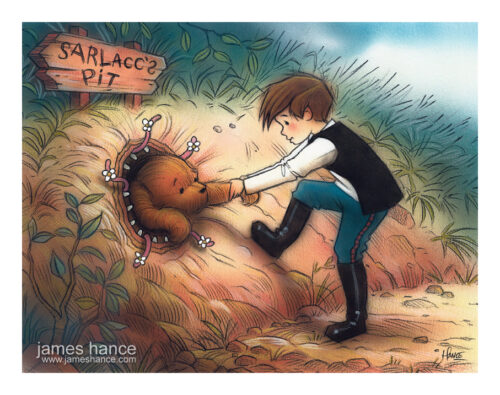
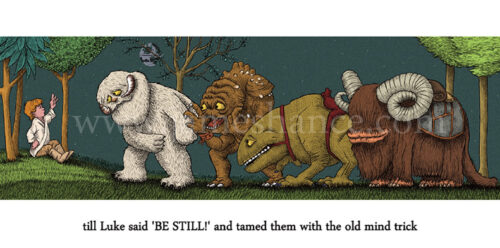
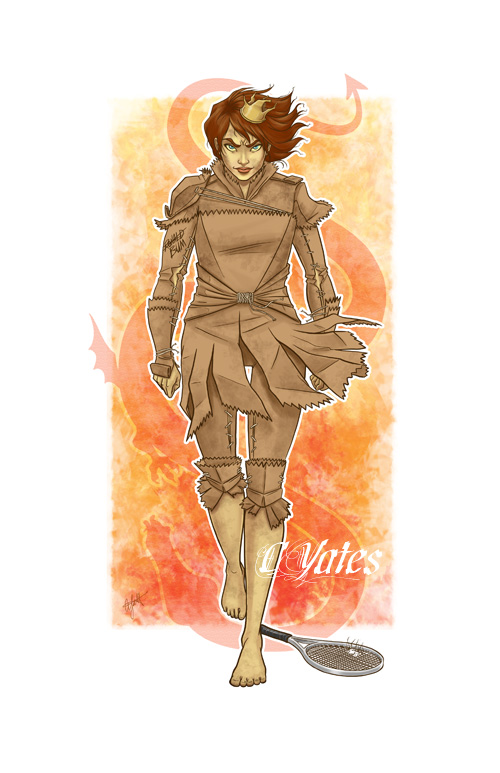
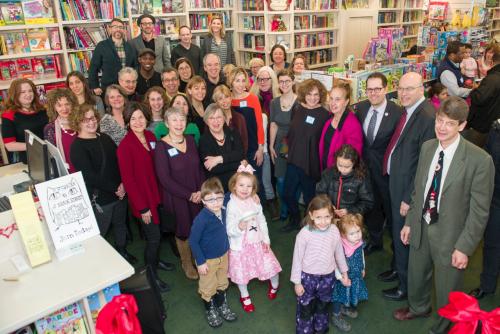
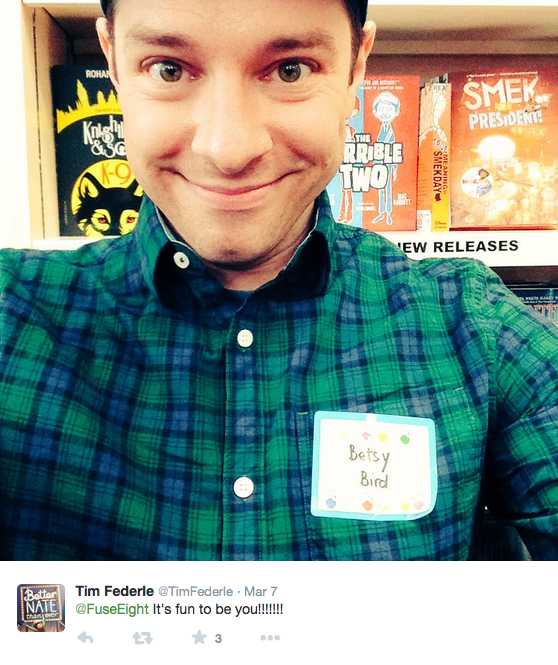




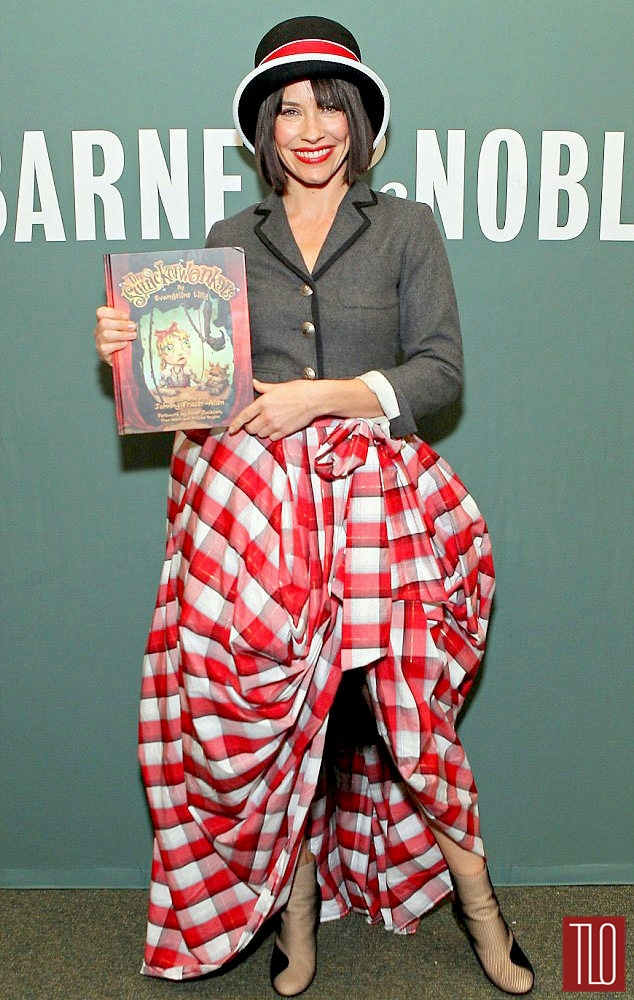





Don’t remember — have you already mentioned Lena Dunham’s HBO Hilary Knight documentary? I’ve got the trailer up here: https://medinger.wordpress.com/2015/03/07/lena-hilary-and-eloise/
Yep. Included it in a Video Sunday, though I didn’t post the trailer. Thanks!
In fact, as an update to that Video Sunday post, I have it on good authority that Richard Peck has sent Ms. Dunham a signed copy of Fair Weather in response to her tattoo of the same name.
There was a Charles Addams from many years ago in which an octopus or sea monster appeared through a manhole and grabbed a man off the street, while the victim tried to fight it off with an umbrella. All the people walked past without noticing, except for one man who stood there shocked. (apparently an out-of-towner) His friend said to him, “It takes a lot to draw a crowd in New York.”
BTW, is that you on the Rockettes’ set?
You are flattering me. But from this distance it could be. I’m going to all out lie and say yes. Yes, that’s me.
Charles Addams knew this city well. I may go read his Mother Goose in memory of him.
Betsy, first off—it was a pleasure getting to talk to you at the Bank Street Grand Opening By the way, you left Jerry’s name tag and your own, and even Tim left your name tag after he’d borrowed it (I watched him take that selfie lol), both stuck to the tablecloth ’til the end of the day. Remember how you said you save everything and I said I do too? Guess who has the name tags now? And no, you can’t have them back!
By the way, you left Jerry’s name tag and your own, and even Tim left your name tag after he’d borrowed it (I watched him take that selfie lol), both stuck to the tablecloth ’til the end of the day. Remember how you said you save everything and I said I do too? Guess who has the name tags now? And no, you can’t have them back! 
OK, this post is SO packed with great stuff, I want to touch on a few, so humor me, please
You spoke of poetry for children. JUST read a great post (https://bookseedstudio.wordpress.com/2015/03/06/books-let-in-the-stars/) that is “skin prickles” praising LET IN THE STARS (love the title!)
I agree we do not deserve a federation. Brits are definitely cooler than we are and, sadly, I think it will always remain that way : /
The “Seuss” post IS amazing! Lots of stuff I’ve never heard/seen before! Thanks for that link
Lots of fun learning more about you in the Forbes article (will shortly be reading the “Introvert” one)
Am now subscribed to The BiblioFiles! Thank you very much


And I’m guessing that’s Fortitude whose head is turned, checking out the female in front of the beautiful NYPL facade? Wow! Just love those lions
Thanks for such a great post, Betsy
Great seeing you too! And that is indeed Fortitude turning his head. Patience is always on the left, Fortitude on the right. And if you stand in the center of 5th Avenue between the two you’ll probably be hit by a bus, but just before you are you can see that they both are looking directly at you. And thanks too for the poetry book link. Doesn’t look like it’s available through Baker & Taylor, which is a bummer. I’ll check and see if Ingram sells it later.
That’s the best thing about New Yorkers! Nothing fazes us. It also means that we feel free to dress/act bizarrely because no one will give us a second glance.
GREAT to hear news about Hilary Knight. We did two books together for Simon & Schuster – SIDE BY SIDE and HAPPY BIRTHDAY. Love him! Lee Bennett Hopkins